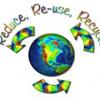Let’s Talk Trash - April 2023 – What Happens To My Recycling?
Let’s Talk Trash - April 2023 – What Happens To My Recycling?
In January of 2023, two previously separate categories of recycling – known as Plastic Bags & Overwrap and Other Flexible Packaging - were amalgamated into a single category called Flexible Plastics. Now, when you go to the recycling depot, all your soft and flexible packaging go into one supersack.
If your dubious about what happens with your recycling once it leaves your hands, read on.
Step 1. It all begins with collection at the depot. After bringing your recycling in (clean and dry) and sorting it into the proper category, your friendly depot workers bale it so it can be moved off island in efficient bundles. Currently the Lasqueti depot requires four barged recycling runs per year on a barge to Powell River.
Step 2. Once the baled recycling reaches Powell River it is transported to a Material Recovery Facility (MRF) either in the Richmond or New Westminster processing facility. These are designed to sort recycling into multiple grades of material using the latest technology of automation.
Step 3. Sorting. On conveyor belts, the recycling then passes through a manual picking phase and then moves through fiber screens, magnetic separators, eddy currents, optical sorters, and air jets to be sorted into categories of similar materials. Paper, plastic, metal and glass are separated, though glass and styrofoam are never co-mingled in loads due to their tendency to shatter and contaminate loads.
Step 4. The sorted material is baled and prepared for end markets.
Step 5. The bales of recycled material are shipped to remanufacturing facilities to be made into new packaging and products. Recycle BC, the non-profit that is tasked in BC with collecting, processing and sorting depot and curbside materials from residents, then approves and verifies the end markets, while trying to keep them as local as possible. From the outset, in 2015, RecycleBC (formerly Multi Materials BC), planned not to ship materials for processing abroad. Some materials that are processed in North America are still marketed outside of NA, but most can find end markets closer to home.
Step 6. Recycled material is turned back into its original product or pelletized.
Merlin Plastics in Vancouver is an end market for plastic which uses pellets for new product manufacturing, ie furniture, car bumpers, shelving, crown moulding and picture frames.
End markets for metal include BC, Ontario and the US. Metal can be recycled indefinitely. It is shredded, smelted and rolled into sheets, wire and new containers/packaging.
Paper is pulped and pressed into fibre and is marketed overseas, to the US and in BC. It’s made into egg cartons, boxes and other post consumer waste paper products.
Glass remains in BC. It’s used for new containers, sandblast material and construction aggregate.
Step 7. Recycled products are sold back to consumers.
While it’s totally understandable to be doubtful about where our recyclables end up, in the case of materials for the Recycle BC program, we can have confidence they are actually being recycled and managed as locally as markets allow.
The recycling process allows us to reduce the need for use of virgin material extraction. That said, what recycling is not, is an excuse for more consumption. Reduction at the source is always the way to true planetary care and respectful use of resources.



Comments
Post new comment